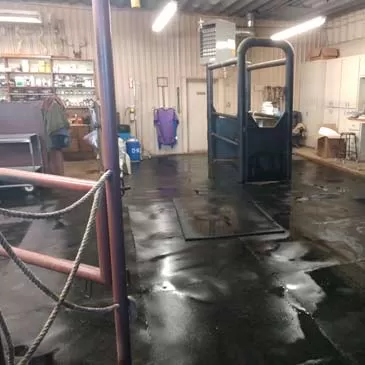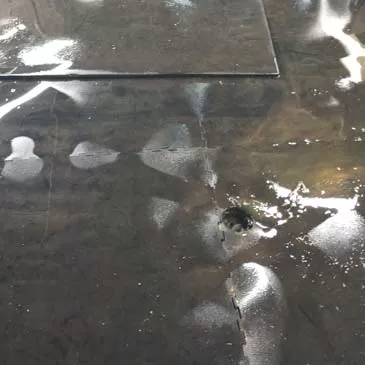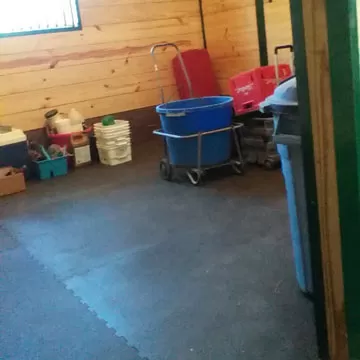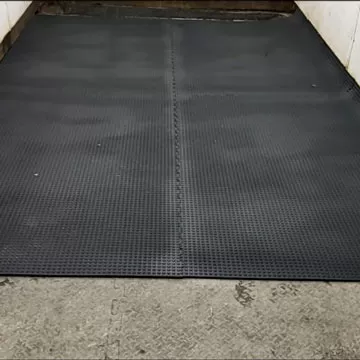How to Clean Horse Stall Mats - Best Methods for Disinfecting
Related Product: Enviro Care Disinfectant Concentrate 1 Gallon
Basics Tools Needed for Disinfecting a Horse Stall

When it comes to disinfecting rubber horse mats, horse barn aisle flooring, or a stall itself, you'll need the right tools for the job. Many horse owners wonder what to clean horse stall mats with. While some use a bleach and water mixture in a garden sprayer, this isn't always the best disinfectant to choose. There are many commercial and veterinary-grade disinfectant products to choose from.
You'll need the following tools to get the job done right:
- Disinfectant
- Water
- Garden sprayer or another type of sprayer
- Scrub brush
- Long pants and a long-sleeved shirt
- Gloves
- Rubber boots
- A fan
Before disinfecting the stall, you should muck out the stall and remove all bedding. Also, try to remove as much debris from the walls.
Cleaning Rubber Horse Stall Mats

- Pull the Mats out of the Stall - To disinfect rubber horse stable mats, begin by pulling the mats out of the stall. Carry them outside (be sure to avoid dragging them along your horse barn aisle flooring, since this can contaminate the barn aisle). Once outside, place the mats in an area that other horses do not access. You should ideally be near a hose.
- Spray Down the Mats with a Hose - Hose any leftover bedding or debris off the mats.
- Apply a Disinfectant - Start by disinfecting the topside of the mats, which is likely the side that is most highly contaminated. Be sure to follow the manufacturer's directions. Generally, you'll leave the disinfectant in place for a certain amount of time before hosing the mats off.
- Repeat this Process for the Underside of the Mats
- Dry the Stall Mats - Always allow the mats to thoroughly dry before replacing them in the stall. Leaning them up against a solid fence can help to speed this process along.
Disinfecting Stable or Stall Walls
While the stall mat is drying, return to the stall and start to work on the walls.- When Manure is Present - If there is manure present on a stall wall, you'll need to scrub it with detergent and water - warm water works best. Remove the manure before you disinfect this section of the stall.
- Start at the Top Work your Way Down - This method prevents a contaminated section from dripping down onto a section that you'd already disinfected.
- Apply Disinfectant to the Walls - Much as you did with the rubber mats, you'll need to apply the disinfectant and allow it to sit.
- Working with Porous Wood - If you're working with porous wood (wood that hasn't been varnished), it will be difficult to ever completely disinfect the stall. However, once the stall is completely dried, you can varnish the wood so that you're able to more effectively disinfect the stall in the future.
Disinfecting Your Horse Stall Flooring

The stall floor, or subfloor, is another area that needs to be disinfected.
- Sweep the Stall Floor - Sweep out any remaining shavings or bedding before you begin.
- Apply Disinfectant - For concrete subfloors, liberally apply disinfectant and scrub areas where debris is stuck, if necessary. Follow the manufacturer's directions in terms of allowing the disinfectant to sit.
- Dry the Stall Floor - You will need to let the floor completely dry - setting up a fan to blow across the floor can help with this.
- Working with Porous Wood - Wooden subfloors are more difficult to disinfect because of the porous issue noted above. You'll need to sweep out any debris or dirt, then will likely need to scrub the floors with the disinfectant. Again, using a fan can help to dry the floor, though the wood floor will take longer to dry than the concrete floor.
Other Horse Stall Flooring Surfaces
If your floor is made of sand, clay, or dirt, then it's almost impossible to truly disinfect it. Instead, you will need to dig down into the floor and remove it. Digging down about 8 to 12 inches is ideal. After removing the flooring, you'll need to replace it with new material - be sure to use a different wheelbarrow and shovel so you don't contaminate the new material.
If you can't remove the floor, then let it dry as thoroughly as possible. Once the floor is completely dry, put down lime and leave the floor to sit. It's best to avoid putting a horse back in the stall for as long as possible - letting the floor sit and dry can help to kill off bacteria.
Replacing Horse Stall Floor Mats

Once your stall is completely disinfected, you can replace the rubber mats. Carry the mats back into the stall and replace them in their original positions. If you've had to replace a sand or dirt stall floor, you'll need to compact the material and make sure that it's even in order for the rubber horse mats to fit correctly.
Additional Items that May Require Disinfecting

If you're working with a stall that has metal bars, you'll need to disinfect them, as well. Use a clean scrub brush to apply disinfectant to the bars. Be sure to cover the areas thoroughly.
You'll also need to disinfect other items in the stall, like a salt block holder, a stall guard, hay racks, the stall door, and eye hooks for water and feed buckets.
If you have a sick horse in your barn, you may also want to take the time to pull out your horse barn aisle flooring to disinfect it, too.
When Should You Disinfect Rubber Horse Stall Mats?

There are many reasons to invest in rubber horse stall mats. Not only do they make your horse's stall safer and easier to clean, but they create a comfortable floor and an even surface for your horse to stand and lie down on. But rubber horse mats have an added benefit: They're easy to disinfect and clean.
Disinfecting rubber horse stall flooring or mats isn't something that you'll do regularly. There's no standard timeline of when you need to disinfect your horse's stall. Often, barn owners only disinfect stalls when there's a sick horse or another reason to do so. But when it comes to disinfecting a stall, having rubber horse mats can make the process both easier and more effective.
Rather, you should plan to disinfect the stall when you encounter the below situations:
- There's a sick horse on the property: If a horse is sick with a contagious disease, then disinfecting stalls may be necessary to help prevent the spread of the disease.
- You're working with a quarantine stall: A designated quarantine stall may need to be disinfected on a regular basis, especially if one of the quarantined horses was ill.
- You're traveling to a show: If you're stabling your horse overnight at a show or competition, you don't know if the horse that was previously in the stall was sick. You should always disinfect the stall before putting your horse into it.
- You've bought a barn: If you've purchased a used barn and are planning to move your horses into it, then it's advisable to disinfect the stalls just in case a sick horse was present.
Disinfecting a stall is time-consuming, but it's well worth the effort if you can prevent the spread of a contagious disease.
Additional Biosecurity Practices
Disinfecting your horse stall is just one of many important biosecurity practices that can help you to prevent the spread of disease. Here are a few more helpful tips:- If you're working with a sick horse, then assign just one person to handle that horse. That person shouldn't handle any other horses in the stable.
- When you introduce a new horse to your barn, always put him into a quarantine period of a minimum of 2 weeks. A 4-week quarantine period is a better option, if possible.
- Never swap water buckets or feed buckets between horses without disinfecting them first.
- Assign each horse his own set of grooming tools, saddle pads, and blankets to avoid transmitting diseases and skin conditions.
- If your facility isn't set up to offer an effective quarantine, then always try to quarantine a horse at an official quarantine facility that has the right setup.
- When traveling to horse shows, don't allow your horse to socialize with others. Monitor your horse's temperature daily and bring along your own supplies, including water and feed buckets.
Hopefully you won't encounter a situation where you need to disinfect horse stalls regularly, as it can be quite the undertaking. However, it's well worth the effort if you can prevent a contagious disease from spreading from horse to horse.














